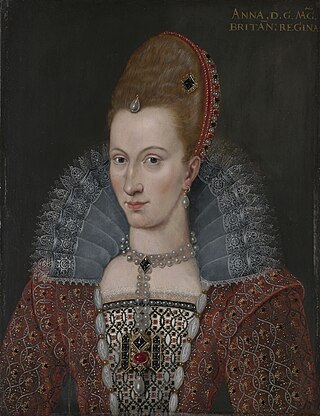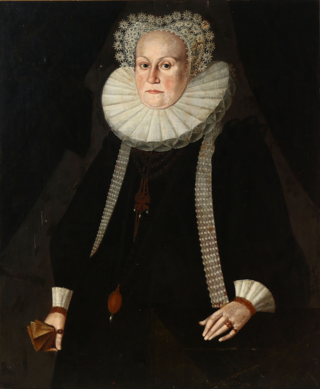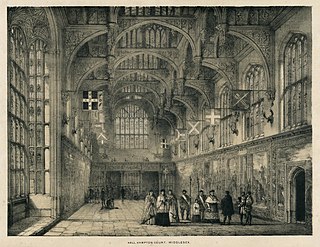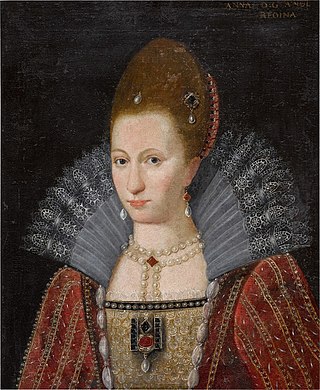Related Research Articles

Anne of Denmark was the wife of King James VI and I. She was Queen of Scotland from their marriage on 20 August 1589 and Queen of England and Ireland from the union of the Scottish and English crowns on 24 March 1603 until her death in 1619.

Ludovic Stewart, 2nd Duke of Lennox and 1st Duke of Richmond, lord of the Manor of Cobham, Kent, was a Scottish nobleman who through their paternal lines was a second cousin of King James VI of Scotland and I of England. He was involved in the Plantation of Ulster in Ireland and the colonization of Maine in New England. Richmond's Island and Cape Richmond as well as Richmond, Maine, are named after him. His magnificent monument with effigies survives in Westminster Abbey.

George Home, 1st Earl of Dunbar, KG, PC was, in the last decade of his life, the most prominent and most influential Scotsman in England. His work lay in the King's Household and in the control of the State Affairs of Scotland and he was the King's chief Scottish advisor. With the full backing and trust of King James he travelled regularly from London to Edinburgh via Berwick-upon-Tweed.
Sir Andrew Sinclair of Ravenscraig, in Denmark known as Anders Sincklar , til Ravenscraig og Sincklarsholm, born 1555, died 1625, was a Scotsman of noble birth, who became a Danish privy counsellor, envoy to England, colonel, and holder of extensive fiefs.

Margaret or Margrethe Vinstarr, was a Danish courtier in Scotland to Anne of Denmark commemorated by the ballad "The Laird o Logie" for rescuing her imprisoned lover.
Margaret Stewart, Mistress of Ochiltree was a courtier in the household of Anne of Denmark in Scotland and looked after her children Prince Henry, Princess Elizabeth, and Charles I of England

On 17 May 1590, Anne of Denmark was crowned Queen of Scotland. There was also a ceremony of joyous entry into Edinburgh on 19 May, an opportunity for spectacle and theatre and allegorical tableaux promoting civic and national identities, similar in many respects to those performed in many other European towns. Celebrations for the arrival of Anne of Denmark in Scotland had been planned and prepared for September 1589, when it was expected she would sail from Denmark with the admirals Peder Munk and Henrik Gyldenstierne. She was delayed by accidents and poor weather and James VI of Scotland joined her in Norway in November. They returned to Scotland in May 1590.

John Gibb of Knock and Carribber (c.1550–1628) was a Scottish landowner and courtier.

Wilhelm von der Wense was a German-speaking courtier and Danish diplomat serving Sophie of Mecklenburg-Güstrow.
Elizabeth or Elspeth Gibb was a Scottish courtier.
Piero or Pierre Hugon was a French servant of Anne of Denmark accused of stealing her jewels.

The jewels of Anne of Denmark (1574–1619), wife of James VI and I and queen consort of Scotland and England, are known from accounts and inventories, and their depiction in portraits by artists including Paul van Somer. A few pieces survive. Some modern historians prefer the name "Anna" to "Anne", following the spelling of numerous examples of her signature.

The Masque of Indian and China Knights was performed at Hampton Court in Richmond, England on 1 January 1604. The masque was not published, and no text survives. It was described in a letter written by Dudley Carleton. The historian Leeds Barroll prefers the title, Masque of the Orient Knights.

Anne of Denmark (1574–1619) was the wife of James VI and I, King of Scotland, and King of England after the Union of Crowns. In 1617, she was depicted in a painting by Paul van Somer with an African servant holding her horse at Oatlands Palace. There are archival records of Africans or people of African descent, often called "Moors" or "Moirs", in her service. One of the first publications to mention Anne of Denmark's "Moir" servant in Scotland was edited by James Thomson Gibson-Craig in 1828.

Anne of Denmark (1574–1619) was the wife of King James VI and I, and as such Queen of Scotland from their marriage by proxy on 20 August 1589 and Queen of England and Ireland from 24 March 1603 until her death in 1619. When Anne intended to sail to Scotland in 1589 her ship was delayed by adverse weather. Contemporary superstition blamed the delays to her voyage and other misfortunes on "contrary winds" summoned by witchcraft. There were witchcraft trials in Denmark and in Scotland. The King's kinsman, Francis Stewart, 5th Earl of Bothwell came into suspicion. The Chancellor of Scotland John Maitland of Thirlestane, thought to be Bothwell's enemy, was lampooned in a poem Rob Stene's Dream, and Anne of Denmark made Maitland her enemy. Historians continue to investigate these events.

Peter Rannald was a Scottish tailor who worked for Anne of Denmark, the wife of James VI of Scotland.

Sophia Stuart was the fourth daughter and last of nine children of James VI and I and Anne of Denmark.
A chamberer was a female attendant of an English queen regnant, queen consort, or princess. There were similar positions in aristocratic households.
Søren Johnson was a Danish courtier in Scotland, serving Anne of Denmark, queen consort of James VI and I as master of the wardrobe.

Anne of Denmark (1574–1619) was the wife of James VI and I, and queen consort of Scotland from 1589, and queen consort of England and Ireland from the union of the Scottish and English crowns in 1603 until her death on 2 March 1619 at Hampton Court. She was buried at Westminster Abbey on 13 May.
References
- ↑ Steven Veerapen, The Wisest Fool: The Lavish Life of James VI and I (Birlinn, 2023), p. 149.
- ↑ Calendar of State Papers Scotland, 1589-1593, vol. 10 (Edinburgh, 1936), no. 458 noted as 'Anne Roos'.
- ↑ Ethel Carleton Williams, Anne of Denmark (Longman: London, 1970), p. 16.
- ↑ Maurice Lee, Dudley Carleton to John Chamberlain, 1603-1624 (Rutgers UP, 1972), p. 34.
- ↑ David Stevenson, Scotland's Last Royal Wedding (Edinburgh, 1997), p. 142: Kancelliets brevbøger vedrørende Danmarks indre forhold i uddrag (Copenhagen, 1908), p. 160
- ↑ James Thomson Gibson-Craig, Papers Relative to the Marriage of King James the Sixth of Scotland, with the Princess Anna of Denmark (Edinburgh, 1827), Appendix, p. 27
- ↑ Tycho Hofman, Portraits historiques des hommes illustres de Dannemark (Copenhagen, 1746), p. 76.
- ↑ David Stevenson, Scotland's Last Royal Wedding (Edinburgh, 1997), pp. 104, 107.
- ↑ Norske Samlinger, vol. 1 (1852), p. 491
- ↑ Jemma Field, 'Dressing a Queen: The Wardrobe of Anna of Denmark at the Scottish Court of King James VI, 1590–1603', The Court Historian, 24:2 (2019), p. 164
- ↑ Michael Pearce, 'Anna of Denmark: Fashioning a Danish Court in Scotland', The Court Historian, 24:2 (2019), p. 147-8.
- ↑ Calendar State Papers Scotland, vol. 10 (Edinburgh, 1936), p. 546.
- ↑ Ethel Carleton Williams, Anne of Denmark (Longman: London, 1970), p. 200.
- ↑ Miscellany of the Abbotsford Club, vol. 1 (Edinburgh, 1837), p. 81
- ↑ John S. Brewer, Court of King James the First by Godfrey Goodman, vol. 1 (London, 1839), p. 169.
- ↑ Ethel Carleton Williams, Anne of Denmark (Longman: London, 1970), p. 203.